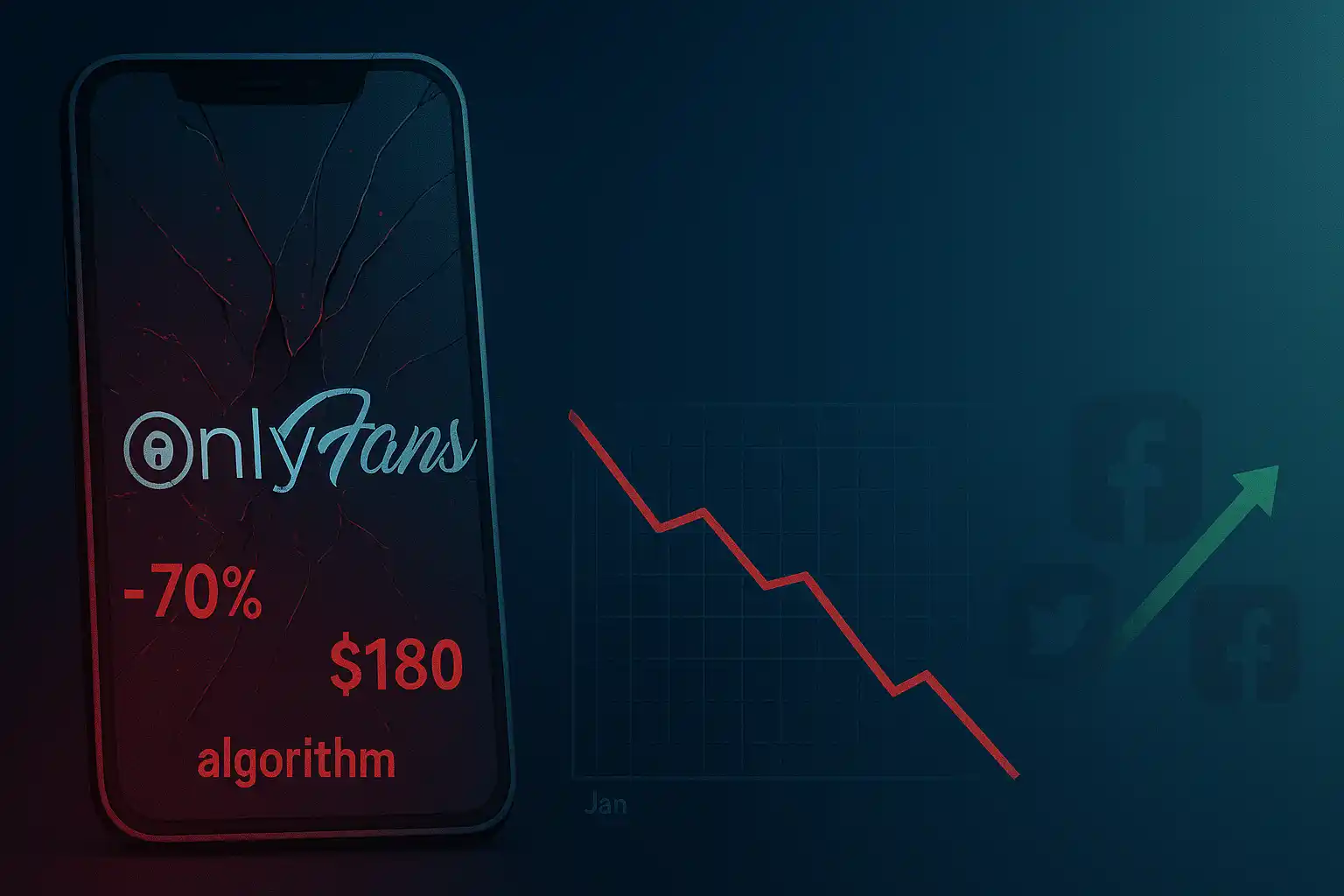On her Instagram, Maria looks like the embodiment of success. Designer clothes, restaurants, travel — the typical picture from the life of a successful 26-year-old. Her OnlyFans brings in $10,000 a month, placing her in the top 5% of the platform's creators. Impressive, right? $120,000 a year without a university degree. Now let's look at the real numbers.
After the platform takes its 20%, after advertising expenses ($1,800 per month), content production ($600), software ($200), and taxes (30% of what's left), Maria is left with $3,200 net. That's $38,400 a year. At 55 hours of work per week, her real hourly rate is $13.40. Less than she earned as a cafe manager.
"Nobody talks about this out loud," Maria shares. "Everyone shows gross figures. Nobody shows expenses. I don't regret my choice, but if I had known all this at the beginning..."
Sound familiar? Then let's figure out how the economics of this industry really works.
How Much Do Sex Workers Really Earn? Numbers Without Embellishment
Forget about gross income. Let's talk about what stays in your pocket after all expenses.
Struggling Independents: Living on the Edge
120 independent escort providers working through budget platforms earn an average of $42,000 per year gross. Sounds decent? Wait. After deducting all expenses, $28,000 remains — that's $2,333 per month.
But here's what's really difficult: instability. One month might bring $5,000, the next — less than a thousand. Try planning life in such conditions. Try saving for an apartment deposit when you don't know how much you'll earn in two months. A quarter of these providers make less than $18,000 net per year. Yes, you read that right — less than minimum wage in many states.
Content Creators: A Lottery Where Almost Everyone Loses
And here's where it gets really interesting. Know how much the average OnlyFans creator earns? Get ready: $180 per month gross. After platform commission and minimal expenses, less than $100 remains. Not a typo. Half of all creators make less than a hundred dollars a month.
| Percentile |
Annual Income |
Per Month |
Reality |
| Bottom 25% |
$400 |
$33 |
Practically nothing |
| Median (50%) |
$1,200 |
$100 |
Pocket money |
| Top 25% |
$6,000 |
$500 |
Side gig |
| Top 10% |
$30,000 |
$2,500 |
Half the median salary |
| Top 5% |
$60,000 |
$5,000 |
Like Maria's |
| Top 1% |
$120,000+ |
$10,000+ |
Real success |
See the pattern? This isn't a career for most — it's a side gig or failed experiment. The chance for a newcomer to reach the top 10% is about 8-12%.
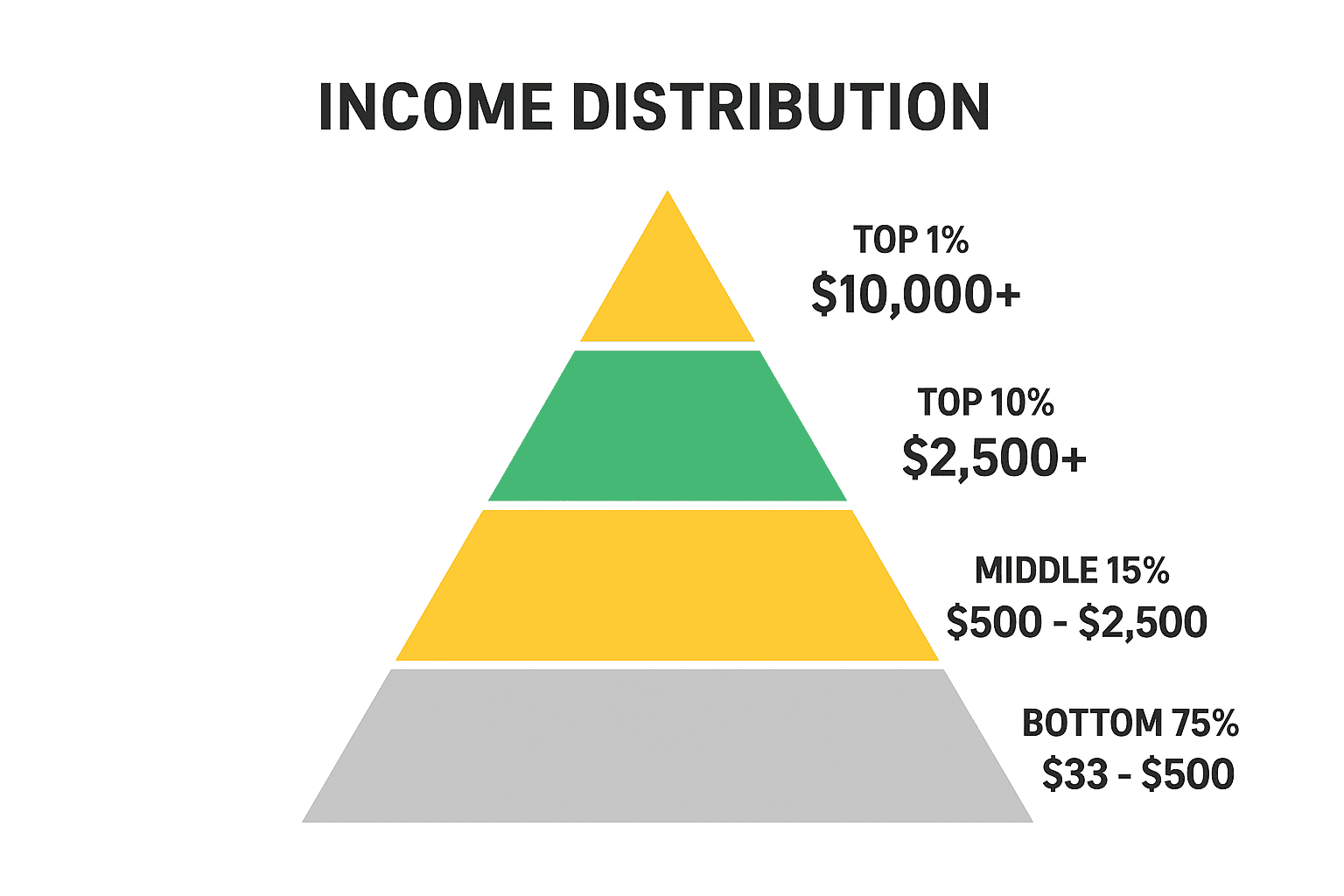
Professional Specialists: When Expertise Pays Off
Now the picture changes. Providers specializing in niches (BDSM, fetish, high-class escort) earn a median of $96,000 gross and $68,000 net — that's $5,667 per month. Most importantly: stability. Specialization creates a permanent client base. Income fluctuates by 25-30%, not 65% like struggling independents.
Multi-Stream Veterans: Diversification Works
Those who combine multiple income sources show the best results: $144,000 gross, $96,000 net ($8,000 per month).
Typical structure:
- Offline meetings (high rates): 55%
- Online subscriptions: 20%
- Passive content: 15%
- Additional services: 10%
When one channel drops, total income decreases by 10-25%, not completely collapses. This is real insurance.
What About Regular Professions?
Median US salary (2025): $58,000.
- Struggling Independents ($28,000): 52% below
- Platform Creators median ($1,200): not viable
- Platform Creators top 10% ($30,000): about half the median
- Professional Specialists ($68,000): 17% above
- Multi-Stream Veterans ($96,000): 66% above
The conclusion is simple: only specialists and diversified veterans earn really well. The rest — below or far below average.
Where Does the Money Go? Detailed Breakdown for Online Creators
Let's be honest: everyone talks about income. Almost nobody — about expenses. But profit is the difference between them.
Platform Fees: The First Hit
OnlyFans and Fansly take 20%. Cam sites — from 30% (Chaturbate) to 50% (premium sites). Clip stores like ManyVids — 40-60%. You earn $5,000 on OnlyFans? A thousand immediately goes to the platform. No options, no negotiations. Own site? Sounds tempting, but then you pay: 2.9% + $0.30 per transaction (regular processors) or 8-15% (high-risk processors for adult content), $50-200 per month for hosting, $200-500 per month for tech support (if hiring a specialist).
Advertising: The Invisible Lifeblood of Business
Here's what many don't understand: subscription platforms don't give you an audience. 78% of traffic comes from outside — Reddit, Twitter, Instagram. And that's either time or money. More often — both.
Online Creator Expenses: Where the Money Goes
| Category |
Expense Item |
Cost ($/month) |
| Promotion |
Reddit (posts, accounts, mass posting) |
$600-1,200 |
| |
Twitter (promoted tweets, engagement) |
$200-400 |
| |
Instagram (promoted posts) |
$100-300 |
| |
Shoutouts and collaborations |
$200-500 |
| |
Total promotion |
$1,100-2,400 |
| Production |
Costumes and lingerie |
$200-600 |
| |
Makeup and grooming |
$100-300 |
| |
Locations (studios, hotels) |
$0-500 |
| |
Props and accessories |
$50-200 |
| |
Equipment depreciation |
$100-200 |
| |
Total production |
$450-1,800 |
| Software |
Editing (Adobe, etc.) |
$50-100 |
| |
Auto-posting and scheduling |
$20-50 |
| |
Analytics |
$20-100 |
| |
Content protection (DMCA) |
$30-100 |
| |
VPN and security |
$10-30 |
| |
Total software |
$130-380 |
| TOTAL EXPENSES |
|
$1,680-4,580 |
At a gross income of $3,000-5,000, this is 22-48% of revenue just for people to find you and for content to be quality.
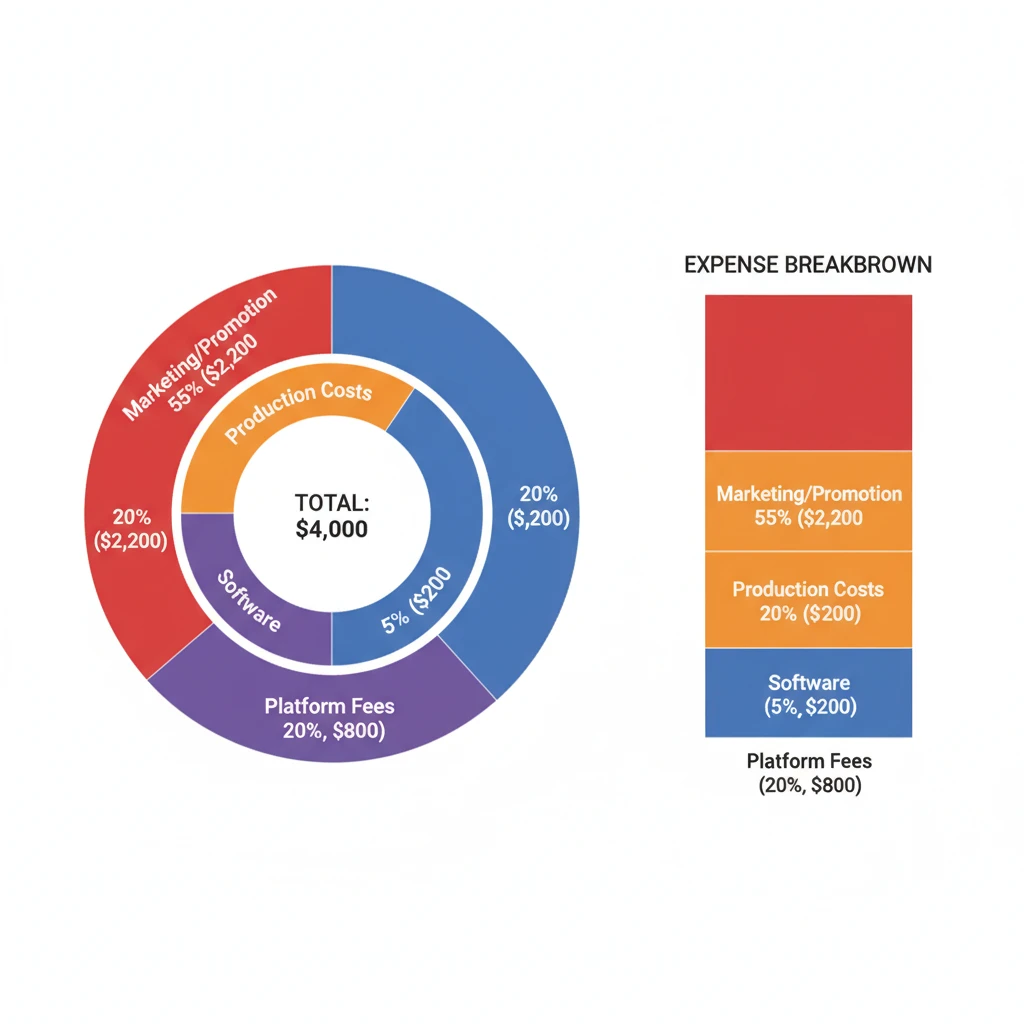
Taxes: Deferred Reality
You're self-employed. This means:
- Federal income: 10-37% (depends on income)
- Self-employment tax: 15.3% (Social Security + Medicare)
- State tax: 0-13.3%
Effective rate at $50,000 net income: 25-35%. A typical beginner mistake? Not setting aside for taxes every month. The IRS requires quarterly payments. Miss them — get penalties and a huge bill at year-end.
Real Example: Alex from Toronto
Gross income: $4,500/month
Deductions:
- OnlyFans (20%): -$900
- Promotion: -$1,400
- Content: -$550
- Software: -$180
- Depreciation: -$150
Net before taxes: $1,320/month
Final net: $924/month ($11,088/year)
Working time: 50 hours/week = 217 hours/month
Real hourly rate: $4.26
Minimum wage in Toronto in 2025: $16.55/hour. See the problem? Gross $4,500 masks the reality of poverty wages at full-time work.
Offline Providers: Different Structure, Same Challenges
Offline work looks different: fewer percentage deductions, but serious fixed costs.
Offline Provider Expenses: Different Structure
| Category |
Details |
Cost ($/month) |
| Advertising |
Tryst premium |
$30-100 |
| |
LolliHub premium |
$50-150 |
| |
Eros |
$300-600 |
| |
Slixa |
$200-400 |
| |
Private Delights |
$150-300 |
| |
Typical combination (2-3 platforms) |
$400-900 |
| Location |
Separate apartment |
$800-2,500 |
| |
OR outcalls (hotels, 50% of meetings) |
$600-1,600 |
| Screening |
P411 annual (amortized) |
$6-13 |
| |
Individual checks |
$10-20 |
| |
Background check tools |
$30-100 |
| |
Total screening |
$50-130 |
| Safety |
Burner phones |
$20-50 |
| |
Personal safety devices (amortized) |
$10-30 |
| |
Security escorts (selective) |
$20-100 |
| |
Legal retainer (optional) |
$0-500 |
| |
Total safety |
$50-200 |
| Health |
STI testing (every 1-3 months) |
$35-100 |
| |
Contraception |
$0-100 |
| |
Health insurance |
$200-600 |
| |
Therapy (1-4 times/month) |
$100-1,000 |
| |
Total health |
$335-1,800 |
| Appearance |
Clothing and lingerie |
$300-800 |
| |
Cosmetics |
$100-300 |
| |
Salons |
$200-500 |
| |
Fitness |
$100-400 |
| |
Photos (amortized) |
$40-165 |
| |
Total appearance |
$740-2,165 |
| Accounting |
Ongoing bookkeeping |
$100-400 |
| |
Software (QuickBooks, etc.) |
$20-50 |
| |
Annual tax prep (amortized) |
$40-125 |
| |
Total accounting |
$160-575 |
Minimum monthly expenses: ~$2,000-3,000 (economical approach)
Typical professional expenses: ~$3,000-5,000
Let's turn these numbers into living stories of two completely different careers.
Jessica's Story: When $500 per Hour Becomes $20
Jessica lives in Chicago and on paper charges a solid $500 per meeting. Sounds impressive, right? But reality turns out to be much more modest. Over the course of a month, she conducts eight meetings, bringing in $4,000 gross income. Seems decent. But the devil, as always, is in the details.
First to go is money for apartment rent for meetings — $1,400 monthly eats up more than a third of income. Then expenses begin that many don't account for: advertising at $180, professional client screening for $25, safety measures another $100. Health and regular check-ups cost $200, and maintaining appearance — another $900. Accounting services add the last $200 to the list of necessary expenses.
When the dust settles, out of four thousand only $995 remains before taxes. After deducting 28% for taxes, Jessica takes home $716 per month — less than $9,000 a year. At the same time, she spends not only 16 hours on the meetings themselves, but another 20 hours on preparation, correspondence, screening, and maintaining online presence. Total: 36 hours of work for an hourly rate of $19.89 — barely above minimum wage in some states.
Jessica's main problem is the trap of low meeting frequency with high fixed costs. The apartment costs the same whether you take eight clients or twenty. Appearance expenses don't decrease with the number of meetings. She's stuck at a point where she earns too little to scale, but can't quit — too much has already been invested.
Natasha's Story: How Proper Positioning Changes Everything
Natasha works in Miami and does things a bit differently. She also doesn't charge astronomical sums — $600 per meeting, just a hundred more than Jessica. But this small difference, multiplied by ten meetings per month instead of eight, gives gross income of $6,000. Already a good start.
Natasha invests more in visibility and reputation: a premium LolliHub account plus placement on Slixa costs $280 — more expensive than Jessica's, but it pays off. Instead of fixed rent, she works through outcalls, meeting clients in hotels, which costs $800 per month but provides flexibility. Screening is slightly more expensive — $30, safety measures, conversely, cheaper — $75, because hotel meetings are safer.
Health is a serious priority for Natasha, she spends $350 on regular check-ups and staying in shape. Appearance costs $1,200 — she works in the premium segment where clients expect a flawless image. A professional accountant for $250 ensures everything is clean with taxes.
After all deductions before taxes, $3,015 remains — three times more than Jessica. Taxes eat up 30%, leaving $2,110 net each month, or more than $25,000 a year. For 20 hours of meetings and 25 hours of related work (total 45 hours), this gives an hourly rate of $46.89 — 2.4 times higher than Jessica's.
Natasha's secret isn't that she charges much more money. The secret is proper positioning: verification on LolliHub creates trust, premium presence attracts quality clients who are willing to pay a bit more and book more frequently. Instead of spending huge money on fixed apartment rent, she pays for flexibility. Her expenses grow with income, rather than eating it regardless of success.
Two women, similar rates, one city of climate difference — but completely different financial realities. The difference between $716 and $2,110 per month is the difference between survival and real earnings. And it's not about luck, it's about business mathematics and positioning strategy.
How Much Is Your Time Worth? Real Hourly Rate
Forget about gross rates. Let's look at how much you really earn per hour accounting for all work.
Invisible Labor: How Much You Really Work
| Activity Type |
Online Creators (hours/week) |
Offline Providers (hours/month) |
| Direct work |
15-25 content creation |
8-20 client meetings |
| Editing |
10-15 post-production |
— |
| Promotion |
10-20 social media |
5-10 profile updates |
| Communication |
5-15 subscribers |
15-30 screening and chat |
| Preparation |
— |
10-20 appearance, location |
| Travel |
— |
5-15 outcalls |
| Admin work |
3-5 |
5-10 |
| TOTAL |
43-80 hours/week |
48-105 hours/month |
See the difference? Most only count direct time. Reality: supporting work exceeds direct by 2-3 times.
Comparative Table: Real Hourly Efficiency
| Segment |
Gross |
Net |
Hours |
Rate |
vs Benchmark |
| OnlyFans median (top 50-25%) |
$1,500 |
$450 |
160 |
$2.81/hour |
⚠️ -61% vs minimum ($7.25) |
| OnlyFans top 10% |
$5,000 |
$1,800 |
200 |
$9.00/hour |
✓ +24% vs minimum |
| Cam-model median |
$2,500 |
$1,400 |
120 |
$11.67/hour |
✓ +61% vs minimum |
| Struggling Independent |
$3,500 |
$1,700 |
70 |
$24.29/hour |
⚠️ -13% vs median ($27.88) |
| Professional Specialist |
$8,000 |
$4,800 |
65 |
$73.85/hour |
✅ +165% vs median |
| Multi-Stream Veteran |
$12,000 |
$8,000 |
100 |
$80.00/hour |
✅ +187% vs median |
All figures per month except hourly rate. US median salary 2025: $27.88/hour
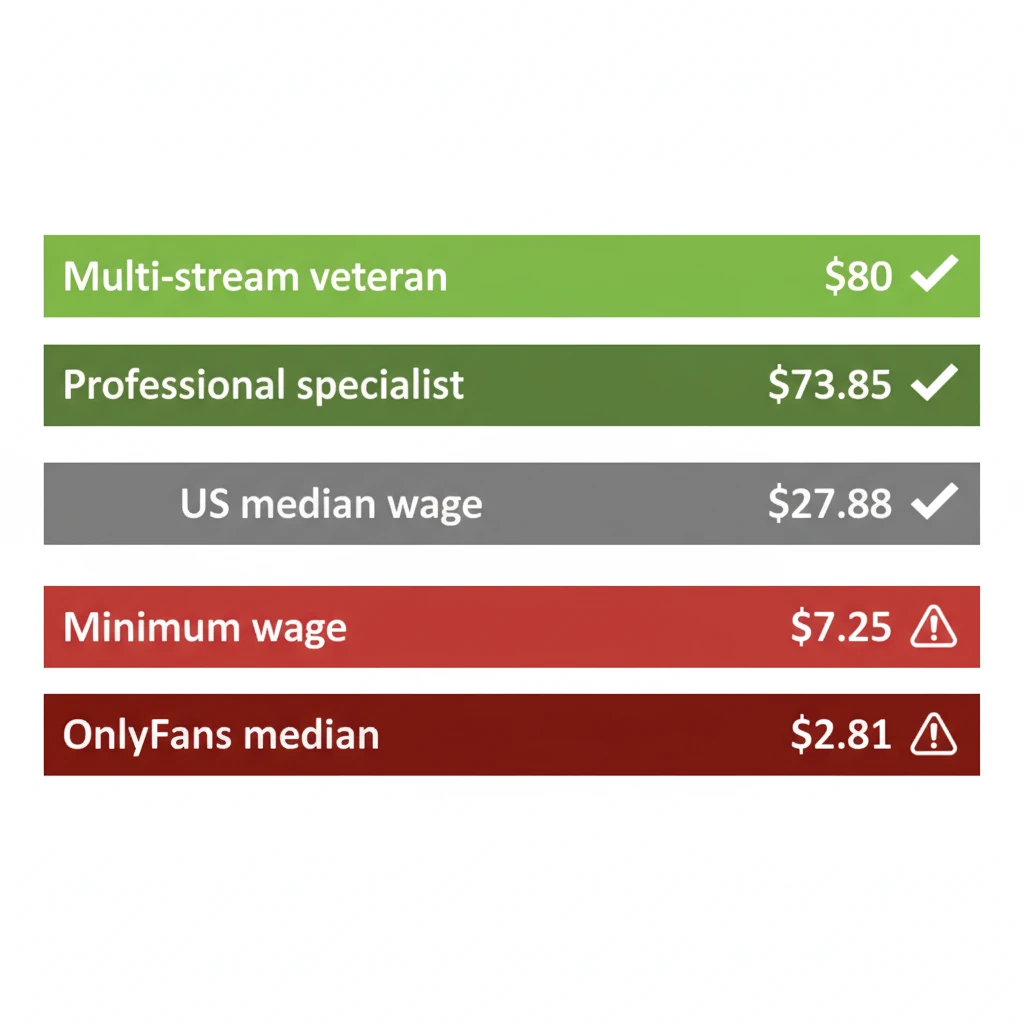
What Does This Mean?
The median online creator works for below minimum wage. Only the top 10% modestly exceed it. Webcam models show better results thanks to immediate monetization and lower promo costs. Struggling independents earn around the median, but with huge instability. Only specialists and veterans truly earn well. The paradox: $500-800/hour per meeting looks luxurious, but the real net hourly rate after all deductions is $25-80/hour.
Hidden Costs: What Doesn't Fit in Tables
You know what's strangest about this work? You can sit with a calculator, count income and expenses, taxes and rent — and still not understand what it all really costs. Because there's a price you can't express in dollars.
Emotional Labor (And Why You Can't Rest From It on Weekends)
Imagine a regular office. You have a bad day — fought with your boyfriend, headache, mood at zero. You can come to work a bit gloomier, do your tasks without radiating joy. Nobody will die.
Now imagine that your job is to always be in the mood. Always wanting. Always being that girl from the client's fantasies. Doesn't matter that an hour ago you got bad news. Doesn't matter that you're tired. Doesn't matter that you don't like this person. You turn on a version of yourself that's genuinely happy to see him.
This is called emotional labor, and it's exhausting in a way that physical fatigue seems like a vacation. You're not just doing work — you're managing others' feelings and your own simultaneously. Creating an illusion of intimacy but maintaining boundaries. Receiving rudeness or disrespect but responding professionally. Rejecting strange requests in a way that doesn't offend or lose the client.
76% of people in the industry say this is the hardest part. Not risks, not money, not the physical part. Just the impossibility of turning off the mask.
And here's what's interesting: those working online start burning out after about a year and a half to two years. Those working in person — after three to four years. But sooner or later it catches up with almost everyone. One day you just realize you can no longer put on the smile. And what to do then — unclear.
Stigma Tax (Or Why You Have to Live a Double Life)
Now add constant lying. Not small, but fundamental — about what you do for a living.
You tell parents you work in marketing or freelance. Friends — something else. Partner either you don't tell at all (and live in fear they'll find out), or you tell and watch how the attitude changes. 68% admit this secrecy kills their personal relationships. Hard to be close to someone when you're hiding half of yourself.
But it's not just about relationships. It's about the future. Because if you later decide to work in finance, law, education, or medicine — your past can destroy everything. Not necessarily will, but the risk is there. And this narrows your opportunities.
Moving? Also a problem. In Berlin or Amsterdam they're relaxed about it. But try moving to a small town in the southern US or a conservative country — there your history can make life unbearable.
Economists call this opportunity cost — what you lose by choosing one thing over another. You can't calculate it, but it really affects your life. It's like a tax you don't pay to the government, but to public opinion. And sometimes it's more expensive than all the money.
Time Works Against You
In a normal career, time is your friend. You work 30-40 years, each year becoming more experienced and valuable. You start at 20, retire at 60, all logical.
Here everything's reversed.
Online content? Realistically working window — 3-5 years. Then algorithms change, audience switches to new faces, earnings drop. You burn out emotionally even earlier.
Cam models last 2-4 years. This is very emotionally intense work, income is unpredictable, burnout comes quickly.
Even offline, where you can charge more and have more control — usually 5-10 years maximum. You get physically tired. Risks accumulate. Stigma presses.
See the difference? You don't have 40 years for a career. You have maybe five. This means you need to save aggressively and immediately. And simultaneously plan the next life that will begin when you're not 60, but maybe 28 or 35.
The Financial System Doesn't Love You
And here's where it gets really fun. Even if you earn well and want to properly save and grow this money — the system actively hinders you.
Banks close accounts when they understand where the money comes from. Not always, but often. Get a loan? Good luck explaining where stable income comes from without an official employer. Mortgage? Even harder.
Regular payment systems like PayPal ban accounts associated with the sex industry. You have to use alternative services with huge fees or mess with cryptocurrency.
Investments, savings, insurance — everything normal people do automatically becomes a quest for you. You earn, but can't use it normally.
Exit Also Costs Money
And when you decide to leave (and most eventually do), a new expense category begins.
Retraining — $10,000-50,000. Courses, certificates, maybe a new degree if you want a normal job.
Resume gap. What were you doing the last 5 years? Either lie (and risk they'll check), or tell the truth (and risk they won't hire you).
Online traces are impossible to delete. Completely. The internet remembers everything. There are services that promise to clean your digital history, but it's expensive and works 70% at most.
All the reputation you built — clients, reviews, recognition — all stays in the past life. You start from zero.
Economists calculated: all these invisible costs reduce your real compensation by 10-20 percent. That is, if on paper you earn $50k per year, in reality the effect is like $40-45k. And sometimes feels even less.
This doesn't mean the work is bad or wrong. It means an honest conversation must include not just income figures, but everything else — what doesn't fit in tables but defines your life.
Where to Advertise: Calculating Real Return
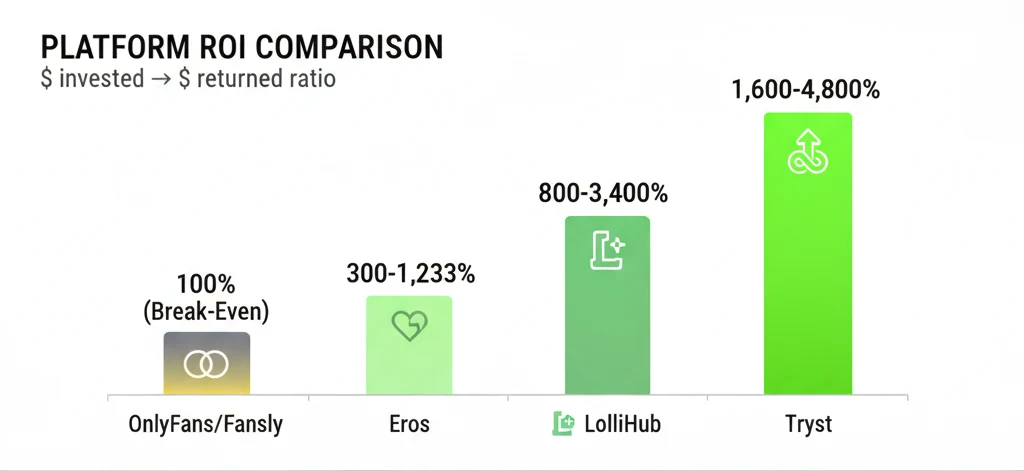
All platforms promise clients, but let's be honest — which ones actually pay off, and which ones you're just draining money on hoping for a miracle?
OnlyFans/Fansly: Lottery for the Chosen Few
Everyone's heard stories about girls who bought a house with OnlyFans. The question is, how many of those barely break even on costs.
The platform takes 20% of every dollar — that's okay, everyone does that. But the real problem is promotion. For anyone to even see you, you need to invest in advertising. Ads from other creators, social media promotion, maybe paid posts from promoters — easily flies away $1,000-2,500 per month.
Let's calculate for a girl who's in the top 20% (not a star, but not a beginner):
- Earns $5,000 gross
- Platform commission: minus $1,000
- Promotion: minus $1,500
- Remains net: $2,500
ROI (return on investment) — 100%. That is, zero profit. Just didn't lose. Break-even, as financiers say.
Now think: to just break even, you need to earn $3,000+ gross. If less — you're working at a loss. And most earn much less than three thousand. So it turns out that for the average person, OnlyFans is more of a loss-making hobby than a business.
Tryst: Best ROI, But There's a Catch
Tryst is almost the opposite of OnlyFans mathematically. The platform is free in basic version, premium costs $50-100 per month. And here the magic begins.
You invest $50, get 2-4 bookings at $400-600. That's $800-2,400 income. ROI — from 1,600% to 4,800%. Read: every dollar invested brings back 16-48 dollars.
Sounds like a dream, right? The problem is that in 2024 the platform changed algorithms, and organic reach dropped. Before you could just create a profile and clients found you themselves. Now more effort is needed — activity, reviews, constant profile updates. Still the best ROI on the market, but not as easy as a year ago.
Eros: Only for Those Who Charge High
Eros is expensive. $300-600 per month for placement. For many, this immediately cuts off the possibility.
But if you charge $500+ per hour and work in the premium segment, the math works:
- You invest $450 per month
- Get 3-6 bookings at $600-1,000
- That's $1,800-6,000 income
- ROI: 300-1,233%
Every dollar invested brings 3-12 dollars back. Not bad if you're in the right price category.
Keyword — right. If you charge $300-400 per meeting, Eros will bankrupt you. Clients on the platform are used to a certain level and aren't looking for budget options. It's like opening a shawarma stand in a neighborhood where they only eat at Michelin-starred restaurants — not your audience.
LolliHub: The Golden Mean
And here LolliHub appears. Costs $0-150 per month depending on package. Say you take the average for $100.
You get 2-5 bookings at $450-700 (middle segment). That's $900-3,500 income. ROI: 800-3,400%. That is, every dollar brings 8-34 dollars.
Why does this work? Balance. The platform is affordable enough to pay off even at average rates. But at the same time there's verification that screens out time-wasters — people who write, ask, arrange, and disappear at the last moment. Less time wasted = more real meetings = better ROI.
In Short:
| Platform |
Monthly Costs |
Typical Income |
ROI |
For Whom |
| OnlyFans/Fansly |
$2,500 (commission + promo) |
$5,000 |
100% (break-even) |
Only top 20%+, others at loss |
| Tryst |
$50-100 |
$800-2,400 |
1,600-4,800% |
Any segment, but organic dropped |
| Eros |
$300-600 |
$1,800-6,000 |
300-1,233% |
Only premium ($500+/hour) |
| LolliHub |
$0-150 |
$900-3,500 |
800-3,400% |
Middle segment, golden mean |
The moral is simple: don't advertise where "everyone hangs out," but where the math works for you. The most popular platform and the most profitable — these are often different things.
How to Earn More: No Magic, Just Math and Common Sense
Stop working yourself to death for pennies. Let's break down how smart people in this industry earn more without turning their lives into a conveyor belt.
Diversification: Don't Put All Eggs in One Basket
Remember the 2020 crisis? Those who worked only offline — were left without money for months. Those who were only on one platform and got banned — woke up without income. That's why smart people don't depend on one source.
If you're online, it might look like this:
- OnlyFans as base (regular subscription)
- Clip stores like ManyVids (shoot once — sells for years)
- Custom content to order (highest margin, clients pay for exclusivity)
- Cam shows when money is needed urgently (live money immediately)
If offline:
- Meetings as foundation
- OnlyFans specifically for regular clients (they like having "access" between meetings)
- Worn items — selling worn clothing (sounds strange, but it's minimal effort for decent money)
Simple statistics: those with three or more income sources have 35% more stable cash flow. And 50% less chance of hitting a financial crisis when one thing falls apart.
Premium Positioning: The High Price Paradox
This will sound strange, but: higher price = fewer clients = better life.
Let's use two real people as examples.
Provider A: charges $300 per hour. To earn normally, needs 15 meetings per month. That's $4,500 gross. But counting time honestly: the meeting itself is an hour, plus preparation, correspondence, travel, getting yourself together after. Turns out 7 hours per client. Total 105 hours of work per month.
Provider B: charges $600 per hour. She needs 8 meetings for $4,800. Same 7 hours per client = 54 hours of work.
Provider B earns 7% more working half as much. After taxes, A's hourly is $43, B's is $89. Difference over a hundred percent.
But it's not just about money. Premium clients are usually a different level:
- Behave more appropriately
- Fewer who write-write-write and end up not showing
- Physically easier (fewer meetings = less wear)
- More time to prepare for each meeting
How to transition there? Don't jump from $300 straight to $600 — clients will be scared off. Raise gradually: plus 10-15% every 3-4 months. Improve photos, profile, presentation. Move to premium platforms. Focus on quality, not quantity.
In a year you'll be in a different price category, and your life will really change.
Volume vs Efficiency: What's Better?
There are two paths.
Path one — high volume: 8-15 meetings per month at $250-400.
- Pros: stable income, clear how much money will come, quickly gain experience
- Cons: physically exhausting, more risks (more people = more chances to run into problems)
Path two — low volume, high rate: 3-6 meetings at $600-1,200.
- Pros: much better hourly, less tired, have time for life
- Cons: unstable (one client cancels — and you're in the red for the month), need ready-made reputation
The golden mean, by many's experience: 6-10 meetings at $500-700. This is a balance of stability, normal income, and that you still have life beyond work.
How to Save Smart (Not on Yourself)
There's a golden rule: cut costs on backend (what clients don't see), never economize on presentation (what they do see).
Here's the real difference:
Online:
- Instead of shooting every day — shoot content for a week in one day (saves 40% time)
- Instead of expensive editor — learn yourself in CapCut (saves $1,000-3,000 per year)
- Instead of paid advertising — organic growth through Reddit and Twitter ($1,000-2,000 per month savings)
- Instead of $3,000 camera — iPhone 15 Pro shoots just as well (saves $1,500-2,500)
Offline:
- Instead of separate apartment — incall at your home, if safe ($1,000-2,000 per month)
- Instead of paid services for client screening — learn to do it yourself ($100-300 per month)
- Buy lingerie and clothes together with other providers wholesale (20-30% cheaper)
- Instead of professional photographer for $1,500 — find a friend with a good camera (saves $1,200-1,800)
But never, hear me, NEVER economize on what the client sees. Bad photos, cheap lingerie, unkempt appearance — this will kill your income faster than anything else.
Passive Income: Let It Work While You Sleep
Now the most interesting — how to make money drip while you do nothing.
Clip stores (ManyVids, Clips4Sale): yes, you first need to invest time and shoot good content. But then it sells for years. A library of 50-100 quality videos can bring $200-800 every month. For years. You shot it in 2023, and in 2027 people are still buying.
Used items (Sofia Gray, Snifffr): selling worn underwear and clothes. Sounds strange, but it's real $50-300 per month with minimal effort. You wear it, photograph it, sell it. That's all.
OnlyFans for regular clients: no promo needed even. Just offer your offline clients "exclusive access" between meetings. $100-500 per month without much effort.
Digital products: if you're already experienced — record a guide or course once. Sell for years. Can bring from $100 to $1,000+ monthly.
In short: work with your head, not just your body. Smart people build systems that bring money even when they're resting.
Case of Successful Optimization: Elena from LA
Before (2023):
- Rates: $350/hour
- Meetings: 12/month
- Gross: $4,200
- Costs: $2,100
- Net after taxes: $1,470
- Hours: 90
- Hourly: $16.33
Changes:
- Raised rates to $550 (gradually)
- Moved from Eros to LolliHub + Slixa (saved $300)
- Reduced frequency to 8 meetings (quality clients)
- Launched OnlyFans for current clients
- Created library on ManyVids
After (2024-2025):
- Rates: $550/hour
- Meetings: 8/month = $4,400
- OnlyFans: $150
- ManyVids: $80
- Gross: $4,630
- Costs: $1,550
- Net after taxes: $2,156
- Hours: 55
- Hourly: $39.20
Result: +140% hourly rate, +47% net income, -39% working hours.
Financial Planning: Think Years Ahead
Short-term maximization is good. But what about the future?
Emergency Fund: Safety Net
Income instability requires serious reserves:
- Minimum: 6 months of expenses
- Optimal: 12 months
At $3,000 monthly expenses = $18,000-36,000 in the fund.
Seems like a lot? But this is protection from:
- Medical emergencies
- Market crises
- Platform changes
- Legal problems
Strategy: automatically transfer 20-30% of each income to a separate account. Consider this a mandatory "expense."
Investments and Retirement
Sex work = short earning window. Need aggressive accumulation.
Retirement Accounts for Self-Employed
| Account Type |
Maximum Contribution (2025) |
Advantages |
For Whom |
| Solo 401(k) |
Up to $69,000/year |
Maximum limit, flexibility |
High income ($80K+) |
| SEP IRA |
Up to 25% of net income |
Simple setup |
Medium income ($40-80K) |
| Roth IRA |
$7,000/year |
Tax-free growth |
All levels (supplement) |
Goal: minimum 15-20% of net income. At $60,000 = $9,000-12,000/year in retirement.
Alternatives:
- Real estate (passive income)
- Index funds (diversification)
- Business investments (eventual transition)
Reality of Early Exit
Average career: 5-10 years. Then 30-40+ years of life.
Calculation:
- Annual expenses: $40,000
- Years in retirement: 40
- Need: $1,600,000 (at 4% withdrawal rate)
How to achieve in 10 years:
- Annual contributions: $80,000 (at 7% return)
- Monthly: $6,667
- Required net income: $100,000+
See? Only multi-stream veterans and top specialists can realistically achieve full retirement through sex work. Most need a second career or adjusted expectations.
Insurance: Protection from Catastrophes
| Insurance Type |
Cost ($/month) |
Why Critical |
| Health insurance |
$200-600 |
Medical bankruptcy — main cause of financial collapse |
| Disability insurance |
$100-300 |
Injury can mean zero income for months |
| Life insurance (if dependents) |
$30-80 |
Protect loved ones in worst scenario |
| TOTAL |
$330-980 |
Non-negotiable for financial security |
Expensive? Yes. Optional? No.
Exit Strategy: Components of Exit Plan
| Component |
When to Start |
Time Investment |
Financial Investment |
| Retraining (online courses, certificates) |
1-2 years before exit |
5-10 hours/week |
$2,000-10,000 |
| Gradual transition (100%→75%→50%) |
6-12 months |
Extended |
Income reduction |
| Leveraging skills (customer service, marketing) |
Constantly |
Minimal |
$0 |
| Financial cushion (12-18 months) |
2-3 years |
— |
$30,000-70,000 |
Exit plan isn't about when to leave. It's about how to leave without going broke.
Honest Conversation at the Finale
Let's sum up without embellishment. The financial truth of sex work is more complex than beautiful Instagram stories. Gross income hides the reality of costs, emotional labor, risks, and short earning window.
What we learned:
The median sex worker earns less than outsiders think. Much less. Only specialized professionals and diversified veterans achieve incomes significantly exceeding regular professions. For most, this isn't a path to wealth. It's a way to make a living — and that's with the right approach.
Key takeaways:
1. Know the Real Numbers
Calculate net hourly rate after ALL costs and FULL time accounting. If it's below your alternatives — reconsider strategy. Don't fool yourself with gross figures.
2. Optimize Ruthlessly
Diversification of sources + premium positioning + cost reduction + passive streams = each optimization adds to your bottom line. These aren't details — it's the difference between survival and prosperity.
3. Plan Long-Term
Emergency fund, retirement savings, insurance, exit strategy — not options, but necessities. Career is short. Life is long. Plan accordingly.
4. Use the Right Platforms
ROI varies from 100% (OnlyFans for most) to 3,000%+ (Tryst, LolliHub). Platform choice isn't a matter of preference, it's mathematics. LolliHub and Tryst give the best ROI for most providers. Eros is justified only for the premium segment.
5. Be Honest With Yourself
This is work. Hard work. With risks, costs, emotional price. "Easy money" doesn't exist. Informed decisions, systematic optimization, realistic planning exist.
Final question: what's next?
If you're already in the industry — use this data for optimization. Where are you losing money? Which platforms give the best ROI? How to increase efficiency? If you're just considering entry — now you know the real numbers. Not Instagram pictures, but spreadsheets. Weigh everything. Calculate everything. Make an informed decision. Sex work can be an economically viable career. But only with informed decision-making, systematic optimization, and realistic planning. Honesty about finances isn't demoralization. It's empowerment. Knowing real numbers allows making better decisions, achieving greater profitability, building more sustainable careers. Now you know the truth. What you do with it — your choice.

 James Whitaker
James Whitaker






